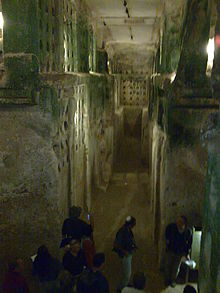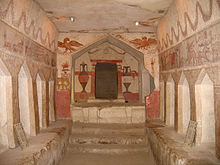- Maresha
-
Tel Maresha (Hebrew: תל מראשה), also Marissa, is an antiquity site in Israel's southern lowlands. The tel was first excavated by the British archaeologists Bliss and Macalister on behalf of the Palestine Exploration Fund. The majority of the artifacts are to be found today in the Museum of Archaeology in Istanbul.
Contents
History
Maresha was one of the cities of Judea during the time of the First Temple and is mentioned among the conquests of the ancient Israelites in the Book of Joshua and later in the Books of Chronicles as one of King Rehoboam's fortifications. In the 6th century BCE, as result of Zedekiah's rebellion against the Babylonian kingdom and its king Nebuchadnezzar II, the latter occupied the Judean kingdom and sent many of its inhabitants into exile. This marked the end of Maresha as a Jewish (or Judean) city.
Following these events, Edomites who had lived south of the Dead Sea migrated north to the area. Hence, from the Persian rule and throughout the Hellenistic kingdoms' rule in the region (6th - 1st century BCE), Maresha was part of the area known as Idumea.
Maresha emerged as a major Edomite city and with the conquest of the region by Alexander the Great the city was settled by retired Greek soldiers as was then custom. Thus Maresha developed as a Hellenistic city encompassing a multitude of Greek and oriental cultures including Sidonians and Nabataeans.
Decline and fall
The city began its decline during the Hasmonean Maccabee rebellion against the Seleucid Empire (2nd century BCE) when the city was used as base to combat the rebels.[1]
Following the rebellion and its success, it is believed that John Hyrcanus conquered the city (112 BCE) and forcibly converted its inhabitants and laid the city to waste.[2] Most opposed the conversion, many abandoned their homes and the city quickly withered into decay.
In 63 BCE, as part of the arrangements made by Pompey in the region, Maresha, along with all of Edom, was separated from the Jewish kingdom and returned it to Idumea. In 47 BCE Julius Caesar then annexed the city to Judea.[3]
Maresha was finally destroyed in 40 BCE by the Parthians as part of the power struggle between Antigonus of the Hasmoneans who had sought their aid and Herod, who was a son of the converted Antipater the Idumaean and was being supported by the Romans.
The area remained barely inhabited until the 2nd century when the Roman city Eleutheropolis was established on the adjacent hills.
Archaeology
Less than 10 percent of the caves on Tel Maresha have been excavated. Located some 1,300 feet above sea level, the ground is chalky and soft, lending itself to the digging of caves which were used as quarries, burial grounds, animal shelters, workshops and spaces for raising doves and pigeons. Many of the caves are linked by an underground maze of passageways.[4]
Tel Maresha and national park
Today Maresha is part of the Israeli national park of Beit Guvrin. Many of the ancient city's olive presses, columbariums and water cisterns can still be seen. Furthermore, Archaeological Seminars, under the license of the Israel Antiquities Authority, conduct excavations of Maresha's many quarried systems and invite visitors to participate.
References
- ^ Haaretz Maccabee-era relics found near Jerusalem shed light on ancient Jewish warriors 16 February 2009 Three fragments of a Greek inscription, believed to be part of the "Heliodoros stele" were recently found at an Israel Antiquities Authority excavation at the National Park of Beit Guvrin.
- ^ Josephus book xxii chapter 8 paragraph 6
- ^ David Noel Freedman, Allen C. Myers, Astrid B. Beck (2000) Eerdmans Dictionary of the Bible ISBN 0802824005 p 856
- ^ Amateur Archaeologists Get the Dirt on the Past, New York Times
Biliography
- Kloner, Amos, Maresha Excavations Final Report I: Subterranean Complexes 21, 44, 70 (Jerusalem, Israel Antiquities Authority, 2003).
- Jacobson, D. M., The Hellenistic Paintings of Marisa (London, Palestine Exploration Fund, 2005).
External links
See also
Coordinates: 31°35′35″N 34°53′54″E / 31.5929633°N 34.8982407°E
Categories:- Ancient Israel and Judah
- Archaeological sites in Israel
- Edom
- Hasmoneans
- National parks of Israel
- Former populated places in Southwest Asia
Wikimedia Foundation. 2010.



